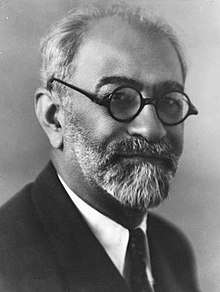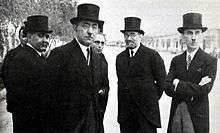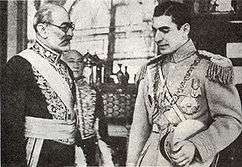Mohammad Ali Foroughi
Mohammad Ali Foroughi (early July 1877[1][2][3] – 26[2] or 27[4][5][6] November 1942, Persian: محمدعلی فروغی) also known as Zoka-ol-Molk (Persian: ذُکاءالمُلک) was a writer, diplomat and politician who was Prime Minister of Iran for three times.
Mohammad-Ali Foroughi | |
|---|---|
محمدعلی فروغی | |
 | |
| 22nd Prime Minister of Iran | |
| In office 27 August 1941 – 9 March 1942 | |
| Monarch | Reza Shah Mohammad Reza Pahlavi |
| Preceded by | Ali Mansur |
| Succeeded by | Ali Soheili |
| In office 18 September 1933 – 3 December 1935 | |
| Monarch | Reza Shah |
| Preceded by | Mehdi Qoli Hedayat |
| Succeeded by | Mahmoud Jam |
| In office 1 November 1925 – 13 June 1926 | |
| Monarch | Reza Shah |
| Preceded by | Reza Shah |
| Succeeded by | Hassan Mostowfi |
| Minister of Finance | |
| In office 1 September 1924 – 1 November 1925 | |
| Prime Minister | Reza Shah |
| In office 15 June 1923 – 26 October 1923 | |
| Prime Minister | Hassan Pirnia |
| In office 14 March 1915 – 1 May 1915 | |
| Prime Minister | Hassan Pirnia |
| In office 24 May 1913 – 3 June 1913 | |
| Prime Minister | Saad ad-Daula |
| Minister of Foreign Affairs | |
| In office 28 October 1923 – 1 September 1924 | |
| Prime Minister | Reza Shah |
| In office 14 February 1923 – 15 June 1923 | |
| Prime Minister | Hassan Mostowfi |
| Minister of Justice | |
| In office 3 June 1913 – 6 December 1914 | |
| Prime Minister | Saad ad-Daula Hassan Mostowfi |
| Speaker of the Parliament | |
| In office 6 July 1912 – 10 July 1912 | |
| Preceded by | Mirza Esmaiel Khan |
| Succeeded by | Hossein Pirnia |
| Member of the Parliament of Iran | |
| In office 19 November 1909 – 3 August 1921 | |
| Constituency | Tehran |
| Personal details | |
| Born | early July 1877[1][2][3] Tehran, Iran |
| Died | 26 November 1942[2] or 27 November 1942[4][5][6] (aged 65) Tehran, Iran |
| Resting place | Ibn Babawayh Cemetery |
| Political party | Revival Party |
| Children | 6 |
| Alma mater | Tehran School of Political Sciences Dar ul-Funun |
The first book was written by him was Western philosophy (the course of wisdom in Europe). Foroughi also edited Saadi's book Koliyat and founded the Academy of Iran. He also attended the Ferdowsi Millennium Congress. In addition, Foroughi has authored numerous works on history (especially ancient Iranian history).[7][8]
Early life and education
Foroughi was born in Tehran to a merchant family from Isfahan. His ancestor, Mirza Abutorab was the representative of Isfahan in Mugan plain during Nader Shah Afshar's coronation. His grandfather, Mohammad Mehdi Arbab Isfahani, was amongst the most influential merchants of Isfahan and was skilled in history and geography. His father Mohammad Hosein Foroughi was the translator of the Shah from Arabic and French. He was also a poet and published a newspaper called Tarbiat. Naser al-Din Shah Qajar nicknamed Mohammad Hosein, Foroughi, after hearing a poem that he had written.[9] During his early life, Foroughi studied at the élite Dar ul-Funun (House of Sciences) in Tehran.
Career
In 1907, Foroughi's father died, and thus Foroughi inherited his father's title of Zoka-ol-Molk.[2] During the same year, Foroughi became the dean of Tehran School of Political Science. In 1909, he entered politics as a member of Majlis (Parliament), representing Tehran. He subsequently became speaker of the house and later minister in several cabinets as well as prime minister three times and once as the acting prime minister when Reza Khan resigned as prime minister to take up the crown as Reza Shah. In 1912, he became the president of the Iranian Supreme Court. Later he was appointed prime minister and dismissed in 1935 due to the father of his son-in-law's, Muhammad Vali Asadi, alleged participation in the riot in Mashhad against the reforms implemented by Reza Shah.[10]
However, later Foroughi regained his status and became Prime Minister during the initial phase of Mohammad Reza Pahlavi's reign.[10] Foroughi as a prime minister was instrumental in having Mohammad Reza Pahlavi proclaimed as king after his father, Reza Shah, was forced to abdicate (16 September 1941) and exiled by the allied forces of the United Kingdom and the Soviet Union during World War II. After the collapse of his cabinet, he was named Minister of Court and then named ambassador of Iran to the United States of America, but he died in Tehran at the age of 67 before he could assume the post.

Books

Foroughi wrote numerous books, including
- The History of Iran,
- The History of the Ancient Peoples of The East,
- A Short History of Ancient Rome,
- Constitutional Etiquette,
- A Concise Course in Physics,
- Far-fetched Thoughts,
- The Wisdom of Socrates,
- The History of Philosophy in Europe,
- My Message to the Academy of Language (Farhangestan),
- The Rules of Oratory or The Technique of Speech Making,
- a book on the Shahnameh (The Book of Kings).
In addition to this, he prepared scholarly editions of the works of Saadi, Hafez, Rumi, Omar Khayyam and Ferdowsi. The best-known of Foroughi's critical editions is Saadi's Kolliyat.
His son Mohsen Foroughi was a renowned architect who completed his studies in France and designed Niavarān Palace Complex, which is situated in the northern part of Tehran, Iran. It consists of several buildings and a museum. The Sahebqraniyeh Palace of the time of Nasir al-Din Shah of Qajar dynasty is also inside this complex. The main Niavaran Palace, completed in 1968, was the primary residence of the last Shah, Mohammad Reza Pahlavi and the Imperial family until the Iranian Revolution. Franz Malekebrahimian worked directly under Mohsen Foruoghi in implementation and maintenance of the Palace.
See also
- Pahlavi Dynasty
- List of Prime Ministers of Iran
- Abdolhossein Teymourtash
- Ali Akbar Davar
- Sayyed Hasan Taqizadeh
References
- Zoka-ol-Molk, Mohammad Ali (2009), Maghalat-e Foroughi مقالات فروغی (in Persian), 1, Tehran: Tous, p. هشت, ISBN 978-964-315-091-4,
در اوایل دههٔ سوم جمادی الآخره ۱۲۹۴ قمری (۱۲۵۶ شمسی و ۱۸۷۷ میلادی) متولد شدهام
- Afshar, Iraj; Azimi, Fakhreddin (31 January 2012). "FORŪGĪ, MOḤAMMAD-ʿALĪ ḎOKĀʾ-AL-MOLK". Encyclopædia Iranica. Vol. X, Fasc. 1. pp. 108–112. Retrieved 27 November 2019.
- Mosaheb, Gholamhossein, ed. (2008). "Forughi, Mohammad Ali" فروغی، محمدعلی. The Persian Encyclopedia. دایرةالمعارف فارسی (in Persian). Vol. 2, Part 1. p. 1887. ISBN 978-964-303-046-9.
جمادی الثانی ۱۲۹۴ ﻫق
- Zoka-ol-Molk, Mohammad Ali (2009), Maghalat-e Foroughi مقالات فروغی (in Persian), 1, Tehran: Tous, p. هجده, ISBN 978-964-315-091-4,
وفات فروغی که در شب جمعهٔ ششم آذرماه ۱۳۲۱ اتفاق افتاد
- Hekmat, Ali-Asghar (1976), Si Khatere az Asr-e Farkhonde-ye Pahlavi سی خاطره از عصر فرخندهٔ پهلوی, Pars, p. 15, retrieved 27 November 2019,
بتاریخجمعهٔ ششمآذر۱۳۲۱ ساعت دهبعد ازظهر دوست دانشمند وبزرگوار، بلکه رئیس عالیمقام و استاد ارجمندم ، محمدعلی فروغی (ذکاءالملکدوم) دراثر بیماری ممتد قلبی جهان را بدرود گفت
- Ettehad, Houshang (2000), Pazhuheshgaran-e Moaser-e Iran پژوهشگران معاصر ایران [Contemporary Scholars of Iran] (in Persian), 1, Tehran: Farhang Moaser, p. 79, ISBN 964-5545-43-9,
جمعه، ۶ آذر سال ۱۳۲۱ ش، ساعت ده بعداز ظهر، محمدعلی فروغی، ذکاءالملک دوم، در اثر بیماری ممتد قلبی، جهان را بدرود گفت
- "با "محمدعلی فروغی" بیشتر آشنا شوید". ایسنا (in Persian). 28 August 2018. Retrieved 21 September 2019.
- "مرگ محمدعلی فروغی سیاستمدار و نخست وزیر رژیم پهلوی". ساعت و تقویم روز ایران (in Persian). Retrieved 21 September 2019.
- Bagher Agheli, A biography of political and military figures in contemporary Iran, Elm publishing, Tehran, 2001.
- Gholam Reza Afkhami (27 October 2008). The Life and Times of the Shah. University of California Press. p. 35. ISBN 978-0-520-25328-5. Retrieved 4 November 2012.
Sources
- 'Alí Rizā Awsatí (عليرضا اوسطى), Iran in the past three centuries (Irān dar Se Qarn-e Goz̲ashteh - ايران در سه قرن گذشته), Volumes 1 and 2 (Paktāb Publishing - انتشارات پاکتاب, Tehran, Iran, 2003). ISBN 964-93406-6-1 (Vol. 1), ISBN 964-93406-5-3 (Vol. 2).
External links
| Wikimedia Commons has media related to Mohammad Ali Foroughi. |
- A short motion picture of Mohammad-Ali Foroughi, from the film archives of Anoshirvan Sepahbodi, Geneva, 1931: YouTube.
| Political offices | ||
|---|---|---|
| Preceded by Reza Khan |
Prime Minister of Iran 1925–1926 |
Succeeded by Mostowfi ol-Mamalek |
| Preceded by Mehdi Qoli Hedayat |
Prime Minister of Iran 1933–1935 |
Succeeded by Mahmoud Jam |
| Preceded by Ali Mansur |
Prime Minister of Iran 1941–1942 |
Succeeded by Ali Soheili |